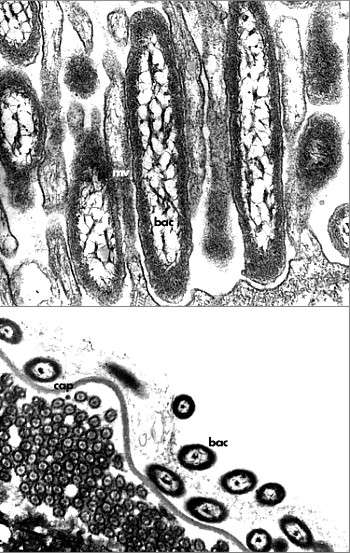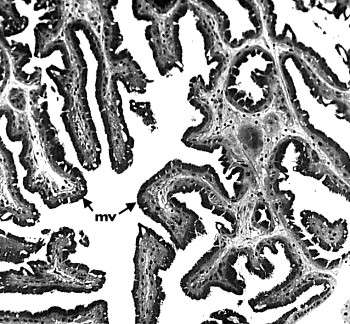

Bacteria in nudibranchs
PHOTO
TOP: Transmission electron micrograph showing the arrangement of bacteria in between the microvilli of the vestibular gland of Dendrodoris nigra in longitudinal section. Abbreviations: bac: bacteria; mv: microvilli. MIDDLE: Transmisson electron micrograph showing the bacteria within the egg mass along the egg capsule. Abbreviations: bac: bacteria; cap: capsule; ci: cilia. LOWER: TEM showing a cross section (2.5 µm) through the vestibular gland. Abbreviations: mv: microvilli.
PHOTOS: Annette Klussmann-Kolb.
Dendrodoris nigra(Stimpson, 1855) is a widespread Indo-West Pacific nudibranch mollusc of the family Dendrodorididae. The genus is notable because of its highly glandular anterior digestive system and lack of radula. The species feeds on non-reticulated sponges of the genera Halichondria and Tedania.
The vestibular gland and egg masses of Dendrodoris nigra were investigated histologically and ultrastructurally. The vestibular gland is attached to the distal oviduct of the sea slug and its function is currently unknown. This gland is thought to be related to reproduction, possibly to
egg mass formation. Detailed investigation of the gland revealed the presence of symbiotic bacteria aligned between the microvilli of the glandular cells. Symbiotic bacteria related to reproduction has not been previously reported for gastropods.
Identical looking bacteria were also found in the mucous layers of its egg masses. The number of bacteria in the egg mass increased during development. These bacteria are not external contaminants but are actively reproducing and are stored within the nudibranch for an apparently functional purpose. We have proposed several hypotheses about their function:
1. the bacteria play a role in the breakdown of the egg mass mucous coating and the egg capsule
2. the bacteria protect the egg mass from colonization by other organisms (e.g. fungi, protozoans)
3. the bacteria may function as a nutritional source for the larvae
4. the bacteria are highly specialised and may be passed from generation to generation.
Further studies are necessary to classify the bacteria and to investigate their role in the life history of the sea slug.
Reference: Klussmann-Kolb, A. & Brodie, G. (1999) Internal storage and production of symbiotic bacteria in the reproductive system of a tropical marine gastropod. Mar. Biol. 133(3): 443-447.
Annette Klussmann-Kolb
Ruhr-Universität Bochum
Spezielle Zoologie
ND05/755
44780 Bochum
GERMANY
Annette.D.Klussmann-Kolb@ruhr-uni-bochum.de
Gilianne D. Brodie
Dept.of Marine Biology
James Cook University,
Townsville 4811,
AUSTRALIA
gilianne.brodie@jcu.edu.au
Klussmann-Kolb, A.D. & Brodie, G.D., 1999 (July 30) Bacteria in nudibranchs. [In] Sea Slug Forum. Australian Museum, Sydney. Available from http://www.seaslugforum.net/find/bacteria
Related messages
Bacterial/archaeal symbionts
March 13, 2001
From: Elissa Murphy
Hello,
I am currently working in a microbial ecology lab while in graduate school at Northeastern University in Boston, Massachusetts, USA. I am currently trying to figure out the direction of my masters project and was wondering if anyone has ever documented the presence of either bacterial or archaeal endo- or ectosymbionts on any species of sea slug?
Any information you could provide would be helpful.
Thank you.
Elissa Murphy
elmurphy@lynx.dac.neu.edu
Murphy, E., 2001 (Mar 13) Bacterial/archaeal symbionts. [Message in] Sea Slug Forum. Australian Museum, Sydney. Available from http://www.seaslugforum.net/find/3890Dear Elissa,
Have a look at the Bacteria in Dendrodoris Page by Annette Klussmann-Kolb & Gilianne Brodie. I think that find of bacteria in Dendrodoris nigra was the first report of a bacterial symbiont amongst the opisthobranchs.
If in your searching you find some other references to bacterial or archaeal endo- or ectosymbionts, I would be grateful if you let me know so I could add them to the Forum
Best wishes,
Bill Rudman
Endosymbiotic bacteria in Nudibranchs
March 3, 2000
From: Joseph Potvin
Dear Dr. Rudman,
I am a student at the University of New Hampshire in the U.S. I am currently taking a course in Marine Microbiology and I am in the process of putting together an independent research project.
I have access to some specimens of Dendronotus frondosus and would like to investigate the possibility of symbiotic bacteria living within these nudibranchs. I am having trouble finding information regarding this type of research or any experimental protocol. Any input you may have would be greatly appreciated.
Sincerely
Joseph Potvin
jpotvin@cisunix.unh.edu
Potvin, J., 2000 (Mar 3) Endosymbiotic bacteria in Nudibranchs. [Message in] Sea Slug Forum. Australian Museum, Sydney. Available from http://www.seaslugforum.net/find/2010Dear Joseph,
I guess you have looked at the Bacteria page. That discovery of bacteria in Dendrodoris nigra by Annette Klussmann-Kolb and Gilianne Brodie is apparently the first record of symbiotic bacteria in any gastropod. Have a look at their publicatiion and if you have further questions you will find their email addresses on that page.
My understanding is that they were not actually searching for bacteria but came across these odd structures during an histological examination of the species. Like many scientific discoveries it resulted from the ability of the researchers to realise that what they saw was worth following up.
If you definitely need to find bacteria another species of Dendrodoris would be more likely than the unrelated Dendronotus but a much more likely group would be the protobranch bivalves of the family Solemyidae. They either have no stomach or a very reduced stomach and live in anaerobic mud. They depend partially or wholly on sulphur-oxidising symbiotic bacteria which live in their gills. I can't tell you where to find them in New Hampshire but there is a species, Solemya borealis in the northwestern Atlantic and species I am familiar with live in shallow water, on muddy, sheltered shores. If you can find a copy of Volume 1 of Mollusca. The Southern Synthesis there is a couple of pages on Solemya and references.
Best wishes,
Bill Rudman.
Bacteria in nudibranchs
July 30, 1999
From: A. Klussmann-Kolb & G. Brodie
Dear Bill
As we promised in Sicily, here is a summary of our discovery of bacteria in Dendrodoris nigra. It is the first record of bacteria in any gastropod.
Annette Klussmann-Kolb
Annette.D.Klussmann-Kolb@ruhr-uni-bochum.de>
Gilianne D. Brodie
gilianne.brodie@jcu.edu.au
Brodie, G. & Klussmann-Kolb, A.D., 1999 (Jul 30) Bacteria in nudibranchs. [Message in] Sea Slug Forum. Australian Museum, Sydney. Available from http://www.seaslugforum.net/find/1033Dear Annette & Gillianne,
Thanks very much for sharing this information with us. I am embarrassed that I can't link your story to a Dendrodoris nigra page. I promise to prepare one as soon as possible.
Best wishes,
Bill Rudman.
